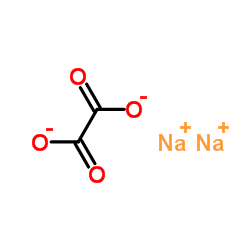Sodium oxalate

Sodium oxalate structure
|
Common Name | Sodium oxalate | ||
|---|---|---|---|---|
| CAS Number | 62-76-0 | Molecular Weight | 133.999 | |
| Density | 2.34 | Boiling Point | 365.1ºC at 760 mmHg | |
| Molecular Formula | Na2C2O4 | Melting Point | 250-270 °C | |
| MSDS | Chinese USA | Flash Point | 188.8ºC | |
| Symbol |

GHS07 |
Signal Word | Warning | |
|
Voltammetric Detection of Oxalic Acid by Using Glassy Carbon Electrodes with Covalently Attached Nitrogen-containing Functional Groups.
Anal. Sci. 31 , 733-5, (2015) We report on a novel voltammetric detection of oxalic acid by using glassy carbon electrodes with covalently attached nitrogen-containing functional groups prepared by stepwise electrolysis. A glassy carbon electrode electrooxidized in an ammonium carbamate s... |
|
|
Are fluoride-containing blood tubes still needed for glucose testing?
Clin. Biochem. 46(4-5) , 289-90, (2013)
|
|
|
Carbonic anhydrase inhibitors. Interaction of isozymes I, II, IV, V, and IX with carboxylates.
Bioorg. Med. Chem. Lett. 15 , 573-8, (2005) A detailed inhibition study of five carbonic anhydrase (CA, EC 4.2.1.1) isozymes with carboxylates including aliphatic (formate, acetate), dicarboxylic (oxalate, malonate), hydroxy/keto acids (l-lactate, l-malate, pyruvate), tricarboxylic (citrate), or aromat... |
|
|
Carbonic anhydrase inhibitors. Inhibition of the beta-class enzymes from the fungal pathogens Candida albicans and Cryptococcus neoformans with aliphatic and aromatic carboxylates.
Bioorg. Med. Chem. 17 , 2654-7, (2009) The inhibition of the beta-carbonic anhydrases (CAs, EC 4.2.1.1) from the pathogenic fungi Cryptococcus neoformans (Can2) and Candida albicans (Nce103) with carboxylates such as the C1-C5 aliphatic carboxylates, oxalate, malonate, maleate, malate, pyruvate, l... |
|
|
Isolation and characterization of oxalotrophic bacteria from tropical soils.
Arch. Microbiol. 197(1) , 65-77, (2015) The oxalate-carbonate pathway (OCP) is a biogeochemical set of reactions that involves the conversion of atmospheric CO2 fixed by plants into biomass and, after the biological recycling of calcium oxalate by fungi and bacteria, into calcium carbonate in terre... |
|
|
The EpiOcular Eye Irritation Test (EIT) for hazard identification and labelling of eye irritating chemicals: protocol optimisation for solid materials and the results after extended shipment.
Altern. Lab. Anim. 43 , 101-27, (2015) The 7th Amendment to the EU Cosmetics Directive and the EU REACH Regulation have reinforced the need for in vitro ocular test methods. Validated in vitro ocular toxicity tests that can predict the human response to chemicals, cosmetics and other consumer prod... |
|
|
Changes in pH and organic acids in mucilage of Eriophorum angustifolium roots after exposure to elevated concentrations of toxic elements.
Environ. Sci. Pollut. Res. Int. 20(3) , 1876-80, (2013) The presence of Eriophorum angustifolium in mine tailings of pyrite maintains a neutral pH, despite weathering, thus lowering the release of toxic elements into acid mine drainage water. We investigated if the presence of slightly elevated levels of free toxi... |
|
|
A new ultrasonic-assisted cloud-point-extraction procedure for pre-concentration and determination of ultra-trace levels of copper in selected beverages and foods by flame atomic absorption spectrometry.
Food Addit. Contam. Part A. Chem. Anal. Control. Expo. Risk Assess. 32 , 1475-87, (2015) A new ultrasonic-assisted cloud-point-extraction (UA-CPE) method was developed for the pre-concentration of Cu(II) in selected beverage and food samples prior to flame atomic absorption spectrometric (FAAS) analysis. For this purpose, Safranin T was used as a... |
|
|
A simplified and robust protocol for immunoglobulin expression in Escherichia coli cell-free protein synthesis systems.
Biotechnol. Prog. 31 , 823-31, (2015) Cell-free protein synthesis (CFPS) systems allow for robust protein expression with easy manipulation of conditions to improve protein yield and folding. Recent technological developments have significantly increased the productivity and reduced the operating... |
|
|
Poly[diacetonitrile-[μ(3)-difluoro-(oxalato)borato]sodium].
Acta Crystallogr. Sect. E Struct. Rep. Online 67(Pt 6) , m678, (2011) The title compound, [Na(C(2)BF(2)O(4))(CH(3)CN)(2)](n), forms infinite two-dimensional layers running parallel to (010). The layers lie across crystallographic mirror planes at y = 1/4 and 3/4. The Na, B and two F atoms reside on these mirror planes. The Na(+... |